Cloud ERP Market Size and Share
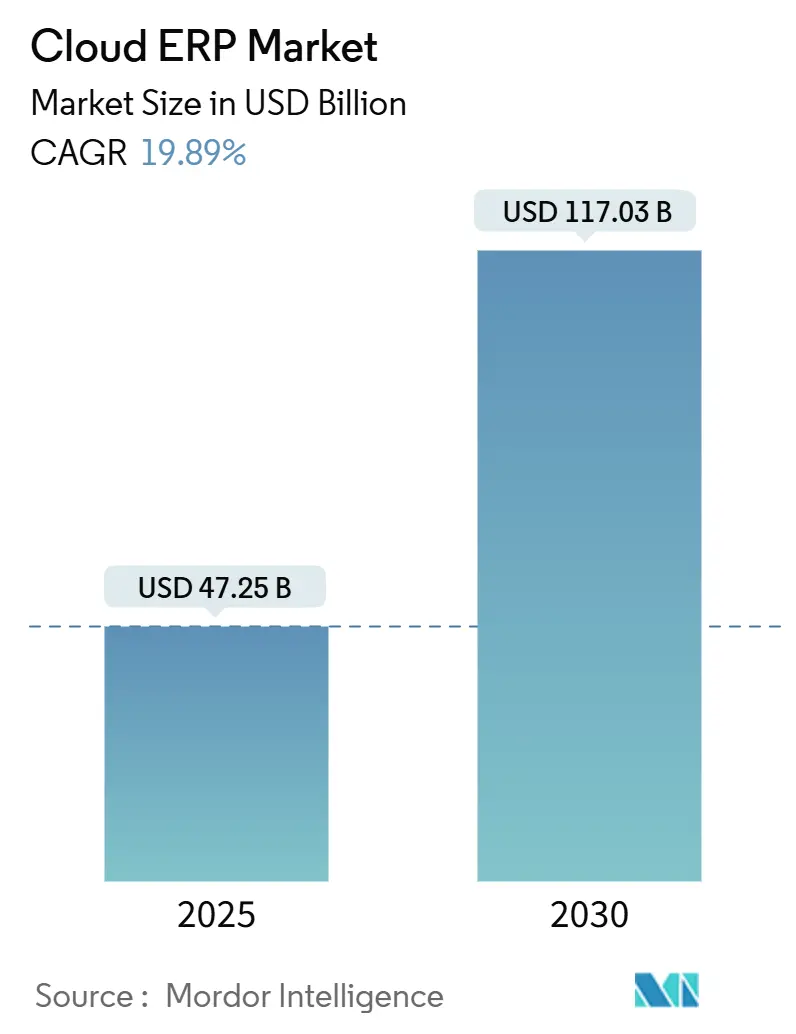
Cloud ERP Market Analysis by Mordor Intelligence
The Cloud ERP Market size is estimated at USD 47.25 billion in 2025, and is expected to reach USD 117.03 billion by 2030, at a CAGR of 19.89% during the forecast period (2025-2030).
This trajectory is underpinned by enterprises that view real-time data access, operational agility, and subscription economics as non-negotiable elements of digital transformation. Sovereign-cloud initiatives and the rapid embedding of AI features keep deployment decisions dynamic, while subscription affordability sustains momentum among small and midsize users. Competitive positioning now revolves around intelligent workflows, low-code extensibility, and localized data centers that address divergent regulatory regimes. The market continues to transition from traditional on-premise environments toward multitenant, consumption-based architectures that deliver faster time-to-value and lower total cost of ownership.
Key Report Takeaways
- By component, solutions led with 67.84% of cloud ERP market share in 2024; services are forecast to expand at a 25.88% CAGR to 2030.
- By deployment model, public cloud captured 64.55% market share in 2024, while private cloud is advancing at a 22.87% CAGR through 2030.
- By enterprise size, large enterprises held 59.92% share of the cloud ERP market in 2024; small and medium enterprises are projected to grow at a 21.22% CAGR to 2030.
- By business function, finance accounted for 38.76% of the market size in 2024, yet human resources is expanding at a 24.69% CAGR through 2030.
- By industry, BFSI commanded 29.20% share of the cloud ERP market size in 2024, while healthcare records the highest projected CAGR at 22.37% to 2030.
- By geography, North America led with 35.40% revenue share in 2024; Asia-Pacific is forecast to post a 27.90% CAGR between 2025 and 2030.
- SAP, Oracle, and Microsoft together represented more than half of global cloud ERP revenue in 2024, with SAP alone reporting EUR 4.25 billion cloud ERP revenue in Q1 2025.
Global Cloud ERP Market Trends and Insights
Drivers Impact Analysis
| Driver | (~) % Impact on CAGR Forecast | Geographic Relevance | Impact Timeline |
|---|---|---|---|
| AI-driven predictive analytics integration | +4.2% | Global, early gains in North America, EU, Asia-Pacific | Medium term (2-4 years) |
| Subscription affordability for SMEs | +3.8% | Global, strong in Asia-Pacific and Latin America | Short term (≤ 2 years) |
| Composable micro-service ERP architectures | +3.1% | North America, EU, spill-over to Asia-Pacific | Medium term (2-4 years) |
| Data-sovereignty-driven sovereign-cloud roll-outs | +2.9% | EU, Asia-Pacific core, selective North America | Long term (≥ 4 years) |
| Marketplace-embedded ERP APIs for micro-enterprises | +2.4% | Global, concentration in emerging markets | Medium term (2-4 years) |
| Asia-Pacific digital-transformation momentum | +2.2% | Asia-Pacific | Short term (≤ 2 years) |
| Source: Mordor Intelligence | |||
AI-driven predictive analytics integration
Artificial intelligence converts cloud ERP from backward-looking reporting to forward-looking decision support. Organizations that embedded AI into ERP reduced delivery times by 25% and cut operational costs by 15% through real-time supply-chain algorithms. SAP reported that AI features appeared in half of all Q4 2024 ERP deals. Oracle’s multicloud database services with built-in AI grew 115% sequentially in Q4 2025, confirming vendor emphasis on intelligent workflows.[1]Oracle Corporation, “Oracle Announces Fiscal 2025 Q4 Results,” oracle.com Manufacturing firms elevate budgets to embed predictive maintenance and production planning, reinforcing AI as a competitive necessity rather than a fringe add-on.
Subscription affordability for SMEs
Subscription pricing removes the capital-expenditure hurdle that once barred smaller firms from enterprise-grade software. NetSuite’s 18,844-customer base translated into 10.35% share of the financial-reporting space in 2024.[2]6sense, “NetSuite Market Share and Customers,” 6sense.com Vista Equity Partners’ USD 2 billion acquisition of Acumatica underscores how predictable monthly fees align with SME cash-flow needs and create room for vendor growth. SMEs now treat cloud ERP as a strategic lever for scaling operations without hiring large IT teams.
Composable micro-service ERP architectures
Enterprises increasingly prefer modular stacks over monolithic suites. Micro-service design lets firms activate only the needed capabilities, speeding deployments and lowering customization costs. A peer-reviewed study finds that micro-services improve system resilience by isolating faults and curbing downtime. Containerization further eases integration with sector-specific applications, translating to faster ROI and reduced vendor lock-in.
Data-sovereignty-driven sovereign-cloud roll-outs
Conflicting jurisdictional rules have moved data residency to the center of procurement criteria. Accenture and Google Cloud opened a Saudi sovereign cloud region to satisfy national mandates without sacrificing scalability. The Cloud Security Alliance underscores rising adoption by regulated industries that cannot house sensitive data outside their borders.[3]Cloud Security Alliance, “Sovereign Clouds: Balancing Compliance and Innovation,” cloudsecurityalliance.org Sovereign offerings combine local compliance with global service catalogs, reshaping vendor footprints.
Restraints Impact Analysis
| Restraint | (~) % Impact on CAGR Forecast | Geographic Relevance | Impact Timeline |
|---|---|---|---|
| Legacy on-premise integration complexity | -2.8% | Global, acute in North America, EU | Short term (≤ 2 years) |
| Multi-tenant security and compliance concerns | -2.1% | Global, heightened in BFSI, Healthcare | Medium term (2-4 years) |
| Hyperscaler egress-fee inflation of TCO | -1.7% | Global, cost-sensitive in emerging markets | Medium term (2-4 years) |
| Low-code ERP-extension talent shortage | -1.4% | North America, EU, expanding to Asia-Pacific | Long term (≥ 4 years) |
| Source: Mordor Intelligence | |||
Legacy on-premise integration complexity
Enterprises with decades-old custom code face protracted migrations. SAP extended mainstream support to 2033 to cushion these transitions.[4]ASUG, “SAP Business AI Strategy Drives Adoption,” asug.com Manufacturing firms report elongated project timelines due to specialized production systems and stringent validation cycles, often increasing budgets well beyond initial estimates.
Multi-tenant security and compliance concerns
Financial and healthcare institutions remain wary of shared-infrastructure risk. The Cloud Security Alliance warns that multi-tenant designs elevate potential attack surfaces and complicate audit trails. Some respond by choosing dedicated cloud instances, forfeiting scale economies but gaining tighter control over data isolation and regulatory alignment.
Segment Analysis
By Component: Solutions retain leadership through platform consolidation
Solutions accounted for 67.84% cloud ERP market share in 2024 as enterprises favored integrated suites that streamline finance, supply chain, and HR in one environment. The dominance stems from the appeal of a single data model that eliminates silos and simplifies governance. Services, however, post the fastest 25.88% CAGR and will deepen the market size as organizations rely on consulting partners for migration roadmaps and continual optimization. Implementation engagements are expanding because legacy landscapes require complex data-cleansing and process-reengineering efforts. Managed services further gain traction among SMEs that prefer to outsource ERP maintenance and focus on revenue-generating activities. The rise of AI features increases demand for training and change management, reinforcing service revenue resilience.
The solutions segment is also buoyed by vendor investments in preconfigured industry templates that shrink deployment timelines. Vendors bundle analytics and robotic-process-automation add-ons to raise subscription value. As AI adoption widens, solution roadmaps increasingly emphasize embedded machine learning for anomaly detection. These innovations keep solution revenue dominant while allowing services partners to monetize lifecycle support. Overall, platform consolidation continues to shape purchasing behavior and sustains the broader cloud ERP market.
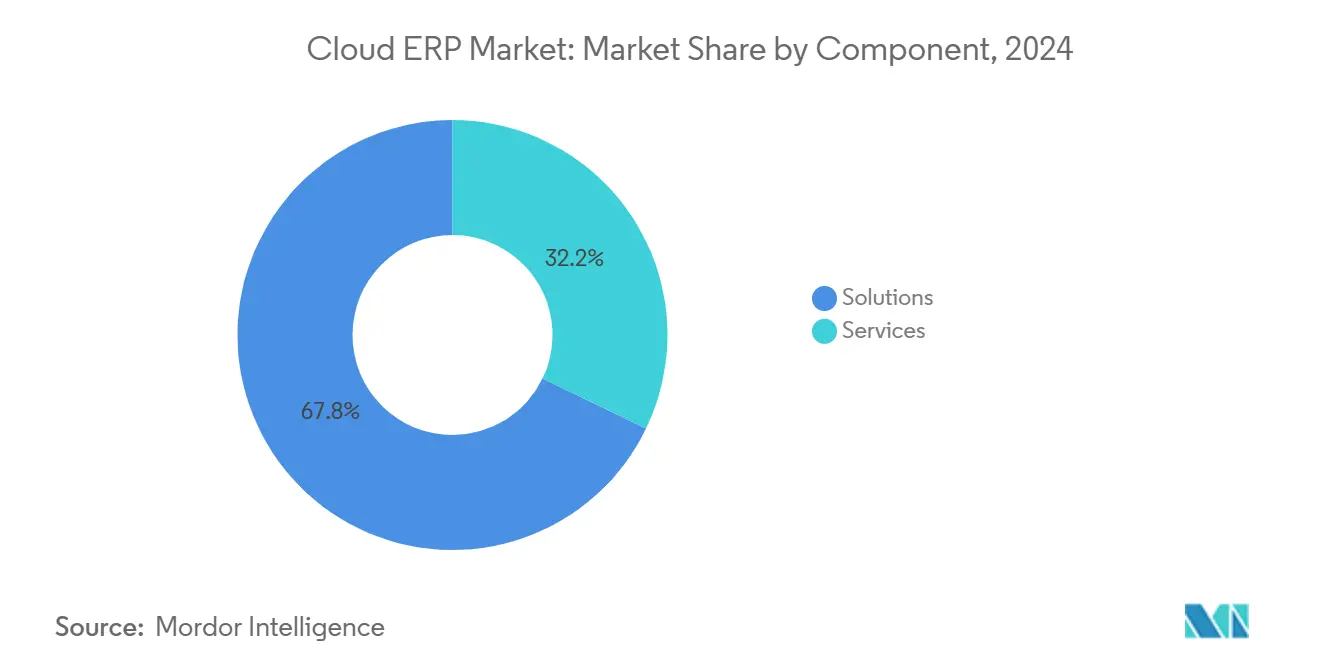
By Deployment Model: Public cloud extends reach while private cloud accelerates
Public cloud captured 64.55% of the cloud ERP market share in 2024, supported by consumption pricing, automated upgrades, and globally distributed data centers. Standardized configurations curtail implementation cost and provide rapid access to new features, which resonates with firms seeking speed over heavy customization. The private cloud model, posting a 22.87% CAGR, reflects rising regulatory scrutiny that necessitates isolated environments without giving up cloud elasticity. Industries such as banking and healthcare require higher degrees of control over encryption, audit trails, and localization.
Hybrid strategies emerge as a pragmatic middle ground. Firms keep sensitive workloads within private instances while pushing less-regulated modules to public regions, thereby controlling risk and optimizing costs. This flexibility aligns with sovereign-cloud mandates that demand in-country data residency. Vendor roadmaps now include automated workload shuttling and consistent policy engines across public and private footprints. Collectively, deployment diversity reduces vendor lock-in fears and enlarges the cloud ERP market size by broadening buyer segments.
By Enterprise Size: Large enterprises lead but SME adoption surges
Large enterprises held 59.92% share of the cloud ERP market in 2024, reflecting their need to standardize processes across global subsidiaries. Multi-national rollouts require extensive change management, multi-language support, and complex intercompany reconciliations, making full-featured suites indispensable. Nonetheless, SME subscriptions grow at 21.22% CAGR, propelled by predictable monthly fees and simplified onboarding. Subscription models map well to SME cash-flow realities, removing the hurdle of capital expenditure.
SMEs are also leveraging accelerator packages that bundle configuration wizards, industry templates, and marketplace apps. These offerings flatten adoption curves and elevate time-to-value, further fueling SME interest. Vendors that target mid-market niches with industry-ready functionality and low-code customization enjoy faster-moving sales cycles. Consequently, the overall cloud ERP market benefits from parallel large-enterprise refresh cycles and first-time SME deployments.
By Business Function: Finance dominance meets HR dynamism
Finance and accounting modules represented 38.76% of the cloud ERP market size in 2024 because accurate financial reporting is mission critical and benefits from global standardization. Enterprises commonly begin ERP journeys with core finance to establish a single source of truth for transactions, audits, and compliance filings. Yet HR solutions are forecast to expand at a 24.69% CAGR as talent retention, hybrid work, and workforce analytics rise to board-level priorities.
HR modules now integrate learning management, employee experience portals, and AI-driven engagement analytics. As a result, HR moves from a back-office system to a strategic planning platform that informs diversity, reskilling, and succession decisions. Finance, meanwhile, continues to evolve through embedded real-time consolidation and predictive cash-flow insights. The two functions increasingly converge through unified data models that support enterprise-wide planning. This consolidation supports sustained growth in the cloud ERP market.
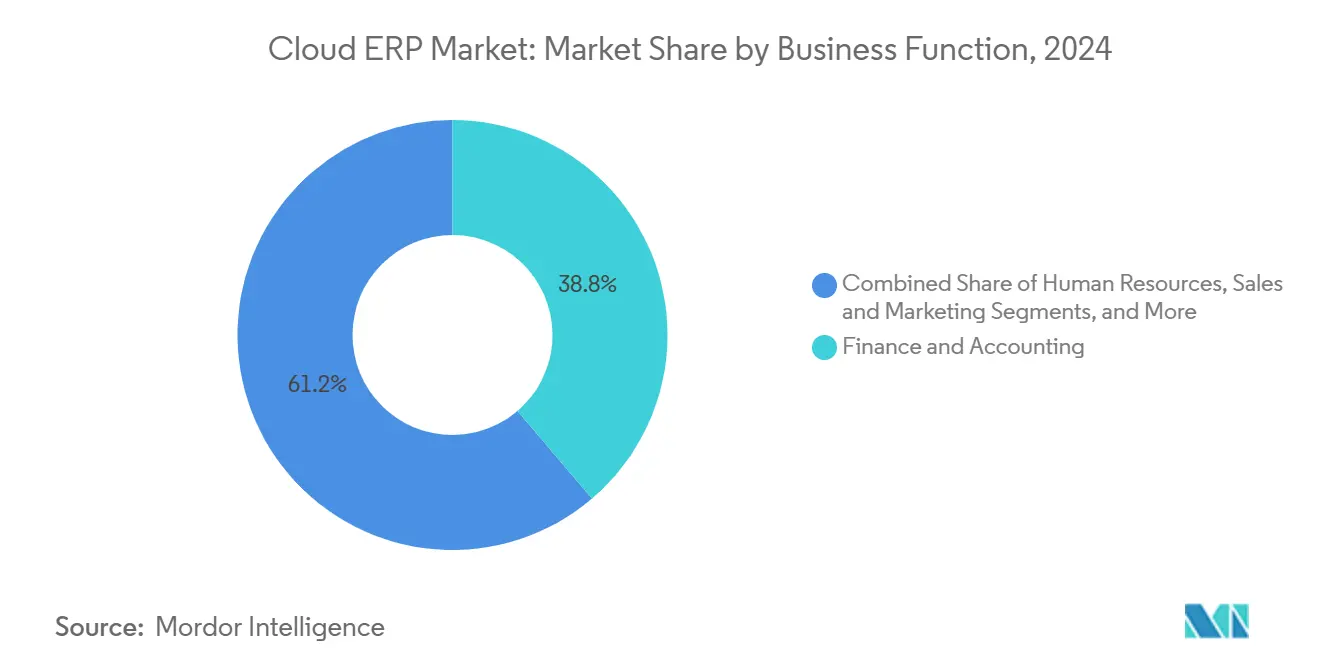
Note: Segment shares of all individual segments available upon report purchase
By End-User Industry: BFSI leadership faces healthcare disruption
BFSI held 29.20% market share in 2024, driven by stringent regulatory reporting and risk-management needs. Banks and insurers use cloud ERP to connect front-office channels, core banking, and finance into one auditable ledger. Simultaneously, healthcare is poised for a 22.37% CAGR as providers digitize patient journeys, regulatory compliance, and supply-chain logistics.
In manufacturing, Industry 4.0 initiatives integrate shop-floor sensors with ERP to enable predictive maintenance and real-time quality control. Government agencies modernize citizen-service platforms by embedding ERP back-ends into digital portals that meet data-sovereignty mandates. Retailers and e-commerce firms integrate omnichannel order management to orchestrate inventory, pricing, and customer experience from a centralized ERP hub. Cross-industry momentum diversifies revenue streams and amplifies the cloud ERP market.
Geography Analysis
North America generated 35.40% of global revenue in 2024, backed by mature cloud infrastructure and a deep ecosystem of implementation partners. Enterprises use the cloud ERP market to refresh legacy suites, consolidate data silos, and align with evolving compliance regimes such as US SEC modernization rules. The presence of major hyperscalers ensures low-latency access and continuous feature delivery. In addition, cross-border entities appreciate region-wide data-privacy frameworks that simplify multinational rollouts.
Asia-Pacific delivers the fastest 27.90% CAGR thanks to government digitalization programs and accelerated economic growth. China’s USD 9.2 billion cloud-infrastructure spend in 2023, with Alibaba Cloud holding 39%, Huawei 19%, and Tencent 15% share, frames the scale of regional investment. Southeast Asian countries tap this infrastructure through strategic alliances, while Japan emphasizes modernizing manufacturing supply chains. The cloud ERP market gains additional lift from local software champions that package industry-specific solutions for export-oriented SMEs.
Europe shows stable expansion rooted in GDPR compliance and sovereign-cloud roadmaps. Enterprises adopt hybrid models that keep sensitive data within EU borders while harnessing foreign regions for less-regulated workflows. Hyperscalers partner with local telecom firms to build trusted cloud zones, enabling public-sector projects that require local control. Meanwhile, Middle East and Africa observe emerging deployments as governments launch e-government programs and diversify economies away from hydrocarbons. These dynamics together enlarge the global cloud ERP market size and deepen vendor localization efforts.
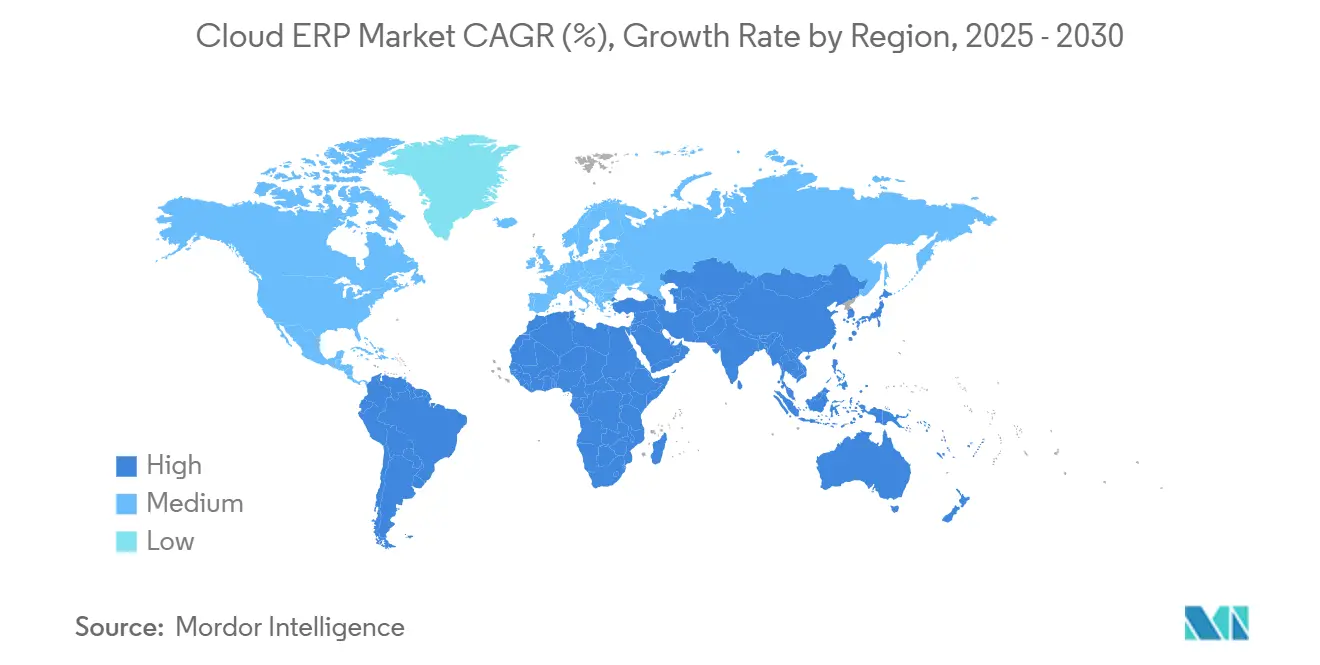
Competitive Landscape
Market concentration sits at a moderate level. SAP, Oracle, and Microsoft account for a majority of worldwide revenue. SAP recorded EUR 4.25 billion in Q1 2025 cloud ERP revenue, a 34% year-over-year rise. Oracle’s Fusion and NetSuite revenues reached USD 2.0 billion in Q4 2025. Microsoft’s Dynamics 365 business grew 16% in Q3 2025 within its USD 42.4 billion cloud portfolio.
Strategic moves emphasize AI, industry depth, and partner ecosystems. Vista Equity Partners’ USD 2 billion buyout of Acumatica expands focus on mid-market customers. Oracle and Microsoft deepened multi-cloud collaboration to serve US government workloads that demand elasticity and stringent security. IBM’s alliance with Oracle delivers AI-powered workflow automations for regulated industries.
Emerging vendors capture vertical niches through cloud-native architectures and composable deployment models. Some focus on manufacturing execution, others on subscription billing or field-service optimization. The acquisition pipeline remains active as incumbents buy specialized players to close functionality gaps. Services partners differentiate by offering accelerators, low-code innovation labs, and managed-security overlays. As AI becomes table stakes, the battlefront shifts to data governance, industry templates, and global sovereign-cloud footprints that deepen the cloud ERP market.
Cloud ERP Industry Leaders
-
SAP SE
-
Oracle Corporation
-
Microsoft Corporation
-
Infor Global Solutions, Inc.
-
Workday, Inc.
- *Disclaimer: Major Players sorted in no particular order
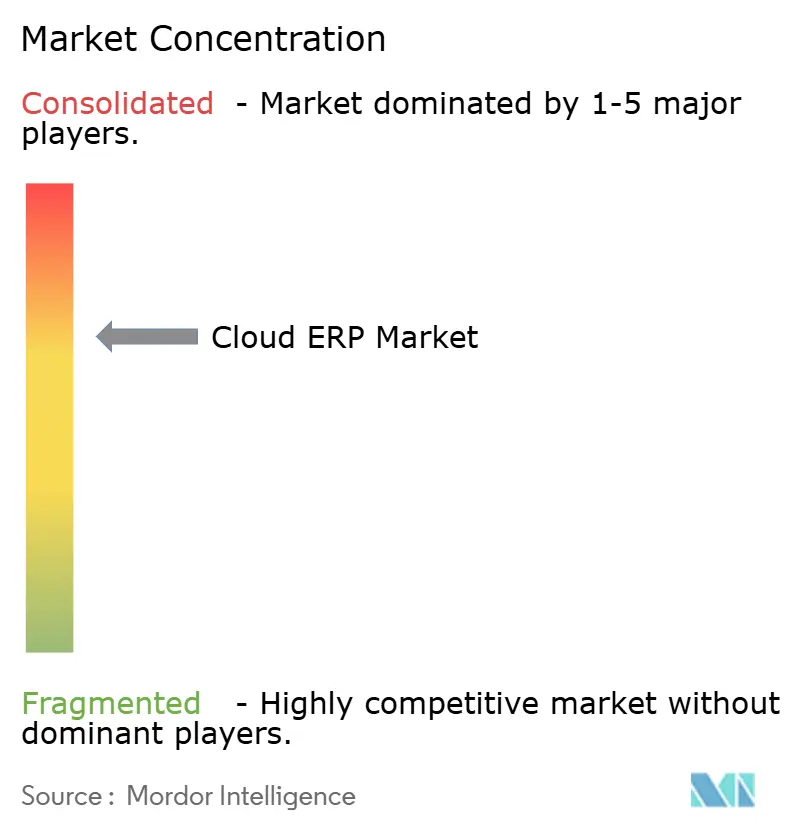
Recent Industry Developments
- January 2025: Deloitte acquired SimplrOps cloud ERP/HCM automation platform to enhance service delivery capabilities and provide clients with advanced configuration management, audit trails, and automated compliance monitoring across enterprise applications.
- May 2025: Vista Equity Partners completed USD 2 billion acquisition of Acumatica, positioning the cloud ERP provider for accelerated growth in mid-market segments through increased investment in product development and market expansion capabilities.
- June 2025: Infor partnered with AWS to launch Infor CloudSuite Industrial Enterprise, adding AI-driven supply-chain optimization to serve manufacturing and logistics clients.
- October 2024: Acumatica released 2024 R2 featuring AI-driven automation, improved user-experience design, and expanded industry functionality for construction, manufacturing, and distribution sectors.
Global Cloud ERP Market Report Scope
Cloud ERP is an enterprise resource planning (ERP) system that runs on a vendor's cloud platform as opposed to an on-premises network. As the IT backbone, cloud ERP software provides advanced functionality for all the core processes in an organization.
The cloud erp market is segmented by component (solutions, services), by deployment (public cloud, private cloud, hybrid cloud), by enterprises (large enterprises, medium and small enterprises), by function (finance and accounting, sales and marketing, human resources, other functions), by end-user (BFSI, IT and telecom, government, retail and e-commerce, healthcare, other end-users), by geography (North America, Europe, Asia-Pacific, Latin America, Middle East and Africa). The market sizes and forecasts are provided in terms of value (USD) for all the above segments.
| Solutions |
| Services |
| Public Cloud |
| Private Cloud |
| Large Enterprises |
| Small and Medium Enterprises |
| Finance and Accounting |
| Human Resources |
| Sales and Marketing |
| Supply Chain and Operations |
| Others |
| BFSI |
| IT and Telecom |
| Manufacturing |
| Government |
| Retail and E-commerce |
| Healthcare |
| Others |
| North America | United States | |
| Canada | ||
| Mexico | ||
| South America | Brazil | |
| Argentina | ||
| Rest of South America | ||
| Europe | Germany | |
| United Kingdom | ||
| France | ||
| Italy | ||
| Spain | ||
| Russia | ||
| Rest of Europe | ||
| Asia-Pacific | China | |
| India | ||
| Japan | ||
| South Korea | ||
| Southeast Asia | ||
| Australia and New Zealand | ||
| Rest of Asia-Pacific | ||
| Middle East and Africa | Middle East | United Arab Emirates |
| Saudi Arabia | ||
| Turkey | ||
| Rest of Middle East | ||
| Africa | South Africa | |
| Nigeria | ||
| Rest of Africa | ||
| By Component | Solutions | ||
| Services | |||
| By Deployment Model | Public Cloud | ||
| Private Cloud | |||
| By End-user Enterprise Size | Large Enterprises | ||
| Small and Medium Enterprises | |||
| By Business Function | Finance and Accounting | ||
| Human Resources | |||
| Sales and Marketing | |||
| Supply Chain and Operations | |||
| Others | |||
| By End-User Industry | BFSI | ||
| IT and Telecom | |||
| Manufacturing | |||
| Government | |||
| Retail and E-commerce | |||
| Healthcare | |||
| Others | |||
| By Region | North America | United States | |
| Canada | |||
| Mexico | |||
| South America | Brazil | ||
| Argentina | |||
| Rest of South America | |||
| Europe | Germany | ||
| United Kingdom | |||
| France | |||
| Italy | |||
| Spain | |||
| Russia | |||
| Rest of Europe | |||
| Asia-Pacific | China | ||
| India | |||
| Japan | |||
| South Korea | |||
| Southeast Asia | |||
| Australia and New Zealand | |||
| Rest of Asia-Pacific | |||
| Middle East and Africa | Middle East | United Arab Emirates | |
| Saudi Arabia | |||
| Turkey | |||
| Rest of Middle East | |||
| Africa | South Africa | ||
| Nigeria | |||
| Rest of Africa | |||
Key Questions Answered in the Report
What is the current size of the cloud ERP market?
The market generated USD 47.25 billion in 2025.
How fast will the cloud ERP market grow through 2030?
It is forecast to expand at a 19.89% CAGR, reaching USD 117.03 billion by 2030.
Which deployment model is growing the fastest?
Private cloud deployments show the highest CAGR at 22.87% as regulated industries seek controlled environments.
Why is AI considered a pivotal driver in cloud ERP adoption?
Embedded AI reduces delivery times by 25% and lowers operating costs by 15%, turning ERP into a predictive decision-support platform.
Which region will experience the strongest growth?
Asia-Pacific is projected to post a 27.90% CAGR due to government digitization programs and rising SME technology investment.
Page last updated on:



